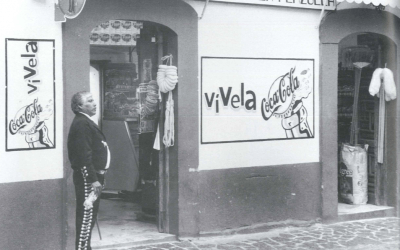The Caribbean
The Glory Days of Tourism in the Caribbean

Dancing aboard Cubana Airlines’ Tropicana Special. Photo by Gordon Winslow.
Tired of the same old vacation on a sandy, sunny Caribbean beach? Are you looking for a little more excitement? how about some rum, rumba, and roulette at a glittery cabaret with fantastic sensuous dancers? Better yet, have you heard about the latest craze described in Cabaret Magazine?
The fledgling nitery is Cubana Airlines’ Tropicana Special, an innovation in cabaret enterprise that has eliminated all the problems of drifting patrons. Jaded nightclub fans in the famed resort are finding that boredom banishes and drinks and entertainment have a new zest when enjoyed in cloudland. As a result, the new nitery in the sky is enjoying a booming business that is the envy of all its earthbound competitors. The Special is designed primarily for bon vivants desirous of sampling the nightlife of nearby Cuba. It takes off every Thursday from Miami’s international airport. An hour later it sets its happier patrons down in the balmy air of the land of daiquiris and sex at Havana’s Aeropuerto José Martí. In between the bibblers are treated to excellent drinks, top-notch Latin music, and a floor show that fills the plane with song and laughter.
If you want to take the Tropicana Special, you will have to return to 1957. Back in the 1950s, Cuba and Haiti were the top Caribbean destinations. Indeed, tourism is one of the Caribbean’s oldest businesses. Among the fifty persons or so who made up Havana’s population when it was founded in 1514, fourteen were temporary visitors, according to the March 1956 Cuba Airguide Tourist Magazine. The Cuban Information Archives offers a fascinating glance into the Caribbean past, including this description from Henry Darling’s “Night Club In The Sky: Cubana Airlines’ Tropicana Special” from a 1957 Cabaret Magazine.
Taking off in the 20th century’s post-war booms and promoted by travel agents, tour operators, airlines and cruise lines, large hotel and resort chains, and international tourism organizations, the tourism industry in the Caribbean emerged to cater to a mass deluge of tourists promising them the “four S’s: sun, sea, sand, and sex.” According to Jay Mullin, who investigated Havana nightlife, a total of 1.5 million visitors were traveling to the Caribbean by 1957, 347,508 of whom were mostly Americans traveling to discover the hidden treasures of the pearl of the Antilles. While sugar was Cuba’s top export, hard currency earnings from tourism, amounting to $60 million annually, was the second largest revenue source surpassing that of Cuba’s other export crops including tobacco. Ever-struggling to lure ever-greater numbers of visitors and foreign direct investment, the Cuban government enacted a law in 1955 permitting the installation of casinos and gambling in all hotels worth over $1,000,000.
The picture changed dramatically in the following decades, or did it? After the Cuban Revolution, the deluge of tourists frequenting the island’s casinos and cabarets became a mere trickle. Revolutionary Cuba shifted its strategy away from tourism dependency, closing up gambling halls and cracking down on prostitution. The number of American visitors declined dramatically following the U.S. economic embargo on Cuba in 1963, forbidding Americans from spending dollars on the island. In the subsequent decade, the few Americans who visited Cuba came as part of solidarity brigades.
Haiti, also a very popular destination in the 1950s, in subsequent decades experienced a similar dramatic fall in visitors, mainly because of political instability, violence, and fear of AIDS. While tourists continue to be lured to the Caribbean by the four Ss, they despise the four Ps’ political upheaval, poor infrastructure, poverty and those things that become “passe.”
Cuba and Haiti illustrate many of the development dilemmas facing Caribbean islands. In islands where economic development options may be further hindered by size and location, tourism can be a significant source of dollar earnings, foreign exchange, investment, and employment. More than 40 years later, tourism continues to be the primary engine of development for most island economies in the Caribbean, promising greater levels of growth than what can be extracted from primary commodities. Yet, as a low-skilled service sector industry the long-term growth implications of building an economy on the base of entertaining short-term visitors may not be as beneficial as one would wish. Nonetheless, both Cuba and Haiti have once again turned to tourism as a part of their development strategy, joining their Caribbean neighbors and struggling with the same dilemma: is tourism a sustainable strategy for pursuing economic and social development? Or is tourism an industry that mostly benefits foreigners at too high a price in terms of a nation’s cultural and social development trajectory?
WHAT HAS CHANGED? PRESENT-DAY TOURISM IN THE CARIBBEAN
High-volume mass tourism, where vacationers prepay travel packages on cruise ships or beach resorts, dominates the tourist industry in the Caribbean. In the last four decades, the number of possible vacation destinations has grown spectacularly as a greater number of islands have developed travel industries, and some have even created their own niches to attract particular types of visitors. As the table below illustrates, no country attracts more than 12 percent of the total 18 million Caribbean visitors to the top 10 destination countries in 2000. Northern tier islands, such as Puerto Rico and Bahamas, have emerged to draw American travelers, while eastern tier islands lured more European and Canadian visitors, and southern tier islands attracted more Latin American visitors.
The Caribbean is a geopolitical construct that includes the following principal islands: Antigua and Barbuda, Bahamas, Barbados, Belize, Cuba, Dominica, Grenada, Dominican Republic, Haiti, Jamaica, St. Kitts and Nevis, St. Lucia, St. Vincent and the Grenadines, Trinidad and Tobago, Anguilla, British Virgin islands, Cayman Islands, Montserrat, Turks and Caicos, Guadaloupe, Guiana, Martini, Puerto Rico, U.S. Virgin Islands, Aruba, Bonaire, Curacao, St. Eustatius, St. Marten, and Saba. With 16 independent countries, 6 semi autonomous Dutch territories, 5 British overseas territories, 3 French overseas departments, a commonwealth associated with the United States, and a U.S. territory, most islands are politically autonomous or are remote outposts of metropolitan countries.
Tourism is still an important vehicle driving the Caribbean’s social economic transformation. Visitor expenditures average 25% of the Gross Domestic Product (GDP) among the top 10 destinations. In 1950, 65,000 tourists visited Puerto Rico and spent $7 million, or $107 per visitor. Today, 4.2 million visitors, 80% of whom are American guests, have transformed the island into the most popular destination in the Caribbean spending $2.139 billion, or $509 per tourist (5.6% of GDP). Even in Cuba, where traffic was halted for many decades, gross tourism revenue is now the country ‘s largest source of hard currency earnings, netting $1.95 billion in revenues (about 9% of GDP). And unlike the rest of the Caribbean, few U.S. tourists visit Cuba, because of Washington’s travel ban. The result is a broader-based industry, with a wider seasonal spread. Canadians form the largest single group, followed by Italians and other Europeans.
TOURISM IN THE CARIBBEAN
Over the past three decades, Caribbean cruise ships have aggressively seized market share from resort hotels on the islands. Lured by the promise of all-inclusive, prepaid packages, brief stops on ports of call, limitless consumption and entertainment, more than 40% of tourists in the Caribbean’s top nine destinations are now embarking on tourism that largely takes place in international waters, mostly unregulated and untaxed. According to the EIU, the Caribbean accounts for almost one-half of worldwide cruise traffic. As a result, cruise passengers far outnumber stopover tourists on several islands including the Bahamas and Cayman Islands.
Even with cruise ship growth in market share, spending per tourist is significantly lower in islands focused on attracting cruise and yacht vacationers. For example, the tourist industry contributed 53.7% of Bahamas’s GDP in 1999, but only 15 cents of each dollar spent in the country remained on the island. Cruise tourism also requires significant investment in port facilities to attract cruise lines. Cuba has invested $6 million in partnership with Genoa-based Costa Crociere, the world’s fifth largest cruise operator, to renovate its port terminal in old Havana to welcome mostly European cruise ships. Last year 76,464 tourists, passengers from 11 ships that made some 260 stopovers, and visited several Cuban port cities, Raquel Mattori observes in a recent article for the Spanish news agency. With this investment, official figures in Cuba estimate that each cruise passenger tourist in Cuba will spend some $150 while visiting the island.
For Caribbean islands, the challenge now is to keep tourists on the islands. In order to attract overnight visitors, the solution has been to build large-scale infrastructure and resorts with intensely developed shorelines. Such is the case in the Dominican Republic and Jamaica, both of whom have invested resources in all-inclusive “enclave” resorts. However, creating these types of enclave resorts requires large-scale investment, the kind not available in most islands’ domestic capital markets. Hence, many Caribbean countries have financed the creation of resorts largely with foreign capital and foreign ownership. Foreign-owned hotel chains and resorts began investing heavily in the Caribbean in the early 1970s. Spanish hotel chain Sol Melia next year will add three more hotels to the 22 it already operates in Cuba. Other Cuban partners include Leisure Canada, a developer of luxury resorts, and Jamaica’s SuperBreezes. These newest projects, aimed at more lucrative upscale travel market, signal a shift in Cuba’s strategy, which traditionally aimed to attract mass-market beach tourists. Similar trends are found in the rest of the Caribbean, where 63% of hotel rooms are foreign-owned, Patty Patullo notes in her 1996 Last Resorts: The Cost of Tourism in the Caribbean (Cassell, London). Yet, with tourists highly sensitive to “passe” venues, over-development in enclave geographic areas a la Acapulco can be a risky venture.
Just as in the 1950s, government policy continues to be very active in tourist industry promotion. Government investment in the infrastructure of tourism zones has been an essential element in tourism’s take-off. In Cuba, the government has also taken a role managing inbound tour operations by providing multiple services through state enterprises. In the case of cruise tourism, however, government policy has been circumvented to the role of investor in services and infrastructure for large multinational corporations. In the Bahamas, for example, governments have attempted to extract a significant contribution to the local economy through the passenger head tax, but these initiatives have been strongly resisted by the industry. With heavy competition, other islands have been similarly reluctant to institute revenue extraction policies.
TOURISM AS A SUSTAINABLE DEVELOPMENT STRATEGY FOR THE CARIBBEAN
Often viewed as both a harbinger of development and destruction, the challenge of insular tourism is to provide visitors with high-quality experiences, while attempting to improve the quality of life of citizens in the host community. In terms of development, tourism presents many challenges, such as the tendency to depend on imported goods and the lack of linkages between tourism and other economic sectors. While the number of arrivals is increasing, in per capita terms tourist expenditures are declining. Intense competition has meant that each traveler spends less money. Skewed benefits create regional as well as domestic inequalities. The current debate centers on whether it is possible to ameliorate these effects while continuing to take advantage of tourism’s development potential.
The goal of sustainable tourism development is to focus on those strategies that more directly contribute to the development of the country as a whole, as well as that of regions and communities. This strategy is based on policies that promote local interests, preserve local landscapes, cultures and heritage, and match industry to local caring capacities. Along these lines, some economies have developed new market niches focused on ecotourism. In the Dominican Republic, for instance, excursions offer trips centered on hiking, caving, and biking through mountains and countryside. Other islands are investing in culture and heritage tourism, Cuba’s Old Havana being the exemplary case in this strategy’s success potential.
Another strategy, albeit indirectly acknowledged as part of tourism’s development, is to exploit the potential revenue from emigres who return to visit their families on the islands. Having experienced significant out migration since the 1960s, many Caribbean islands have considerable proportions of their population residing abroad. In the case of islands such as Puerto Rico, the Dominican Republic, Haiti and Cuba, these visitors have become a greater share of the tourist traffic heading to the island. In the case of Haiti, 60 percent of tourists are emigres coming home for family visits. Rates in other islands are much lower, but nevertheless significant. These tourists are not exactly foreigners; many of them stay with relatives for longer-term stays, rather than short trips to hotels and resorts.
Given the prevailing situation of tourism’s history and present scenarios, the effective practice of this strategy has only been materialized in a microcosm of the Caribbean. As Michael Manley, the late Jamaican prime minister, wrote in his foreword to Patty Pattullo’s Last Resorts:
“The Caribbean needs tourism.” Yet if its underlying dynamics are not understood, it can be an engine of short-term cash enhancement and long-term disaster. The danger lies in an industry increasingly based on the all-inclusive resort, walled off from the surrounding countryside and importing its food and furniture, its designs and designers, its fabrics and fashions from the U.S. mainland: “[W]ith proper planning and popular participation, the tourism sector can become the best market for a great variety of products and activities, involving whole industries, professional groups and individuals. It can be the primary target for our architects and builders, for our artists and crafts people, as well as our farmers…[it] can provide a vital stimulus to regional production.”
Caribbean countries are acutely aware of tourism’s problematic effects on local communities and have attempted to embark on a model that addresses many of the aforementioned problems. But, at best, these countries have been only partially successful. The most feasible and economically viable solution rests upon adopting a diversified strategy for developing their tourist industries. This has meant investing in both luxury beach resorts, cruise passengers, budget and academic travel visitors, ecotourism, family émigré visits as well as cultural and heritage tourism. The challenge for Caribbean countries is to effectively implement a mix of strategies suitable to their own tourism strengths. Only through this path will it be possible to solve the dilemma of tourism as development or development for tourism.
Winter 2002, Volume I, Number 2
Related Articles
Tourism’s Landscape of Knowledge
Tourism research and scholarship is a fairly new interdisciplinary field, and I hope to offer an abbreviated pastiche of this expanding field of knowledge, culled from my own experience….
Tourism and the Archaeology of State – Facing Challenges: the Case of Copan, Honduras
For many nation-states, the achievements of their illustrious ancestors are the source of immense pride, and a focus for national identity. …
Nine Quandaries of Tourism
International tourism presents itself as straightforward, passive and benign, yet it is complex, interesting and important, full of contradictions and depths. Tourism is the world’s largest export …




